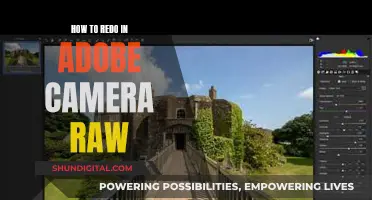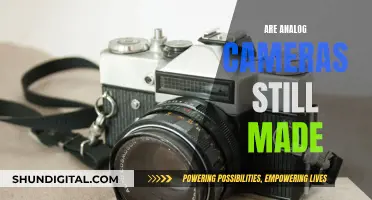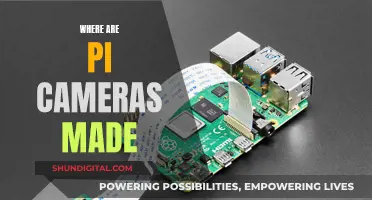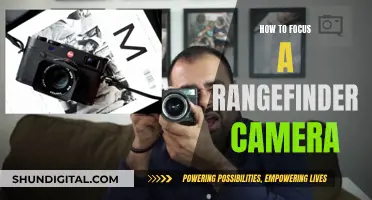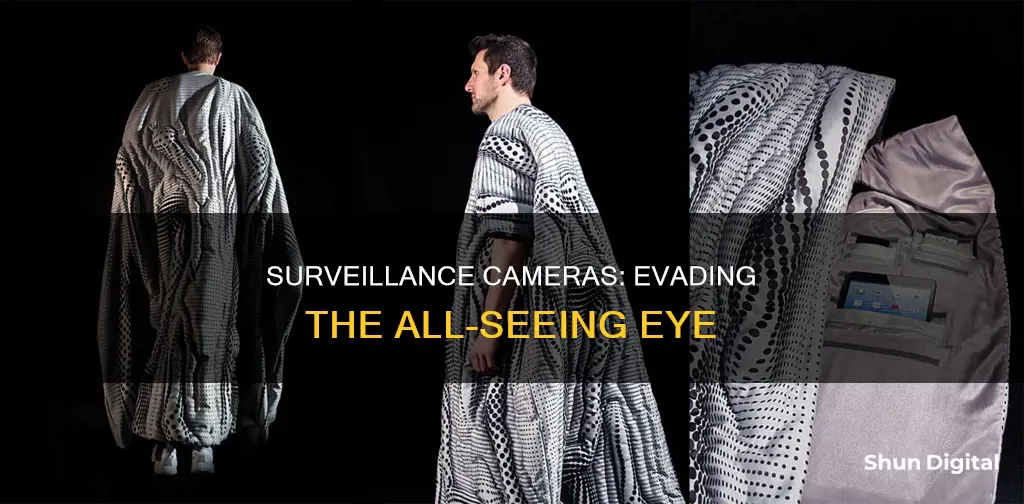
Surveillance cameras are everywhere, from public spaces to our homes, and they pose a significant threat to our privacy. While it is nearly impossible to avoid surveillance entirely, there are ways to minimise the risk of being tracked and protect your personal information. This paragraph will discuss the measures individuals can take to protect their privacy and avoid detection by surveillance cameras.
| Characteristics | Values |
|---|---|
| Wear | Face masks, hats, scarves, helmets, paper masks, anti-surveillance clothing |
| Use | Tape over webcams, cash, burner phones, old phones, strong passwords, Tor and VPN, TAILS, face paint, sunglasses |
| Avoid | Driving, ride-sharing apps, electronic transit cards, credit cards, social media, biometrics |
What You'll Learn

Wear anti-surveillance clothing
Wearing anti-surveillance clothing is one way to protect yourself from surveillance cameras. Here are some ways that clothing can help you avoid detection:
Hyperface Prints
Berlin-based artist Adam Harvey and Hyphen-Labs, an international, all-female design team, collaborated to create the Hyperface project. This project involves printing ghostly patterns of eyes, noses, and mouths onto clothing and textiles. The patterns are designed to confuse facial recognition systems by overwhelming them with too many false faces to read at once, making it harder for the software to identify a real face.
CV Dazzle
Artist Adam Harvey pioneered the CV Dazzle project, which uses avant-garde makeup and hairstyling techniques to disrupt surveillance software. The project's name is derived from a World War I camouflage technique where ships were painted with zig-zag patterns to confuse enemies about their size and direction. Similarly, CV Dazzle aims to break up the continuity of a face, making it harder for algorithms to detect key facial features. This technique involves using bright colours and dark shades of makeup, as well as hair extensions, accessories, and gems, to create an "anti-face."
Anti-Surveillance Coat
Dutch design duo Project KOVR has created the Anti-Surveillance Coat, a trench coat made from metallic fabric that acts as a Faraday cage. This coat shields personal information by rendering computer chips in bank and ID cards unreadable and mobile phones untraceable.
Adversarial Fashion
Hacker and fashion designer Kate Rose has created a clothing line called Adversarial Fashion, which features garments covered in license plate images and circuitry patterns. These patterns are designed to trigger Automated License Plate Readers (ALPRs), injecting junk data into systems used to monitor and track civilians. By doing so, the effectiveness of these surveillance systems is reduced.
Face Masks
Face masks can also be used to avoid detection by facial recognition technology. For example, the artificial intelligence startup company Kneron has discovered that paper masks can trick airport facial recognition technology. Additionally, URME Surveillance offers a 3D-printed prosthetic mask resembling the founder's face, allowing users to shield their identity by being identified as someone else.
While these anti-surveillance clothing options offer some degree of protection, it's important to note that they may not always be effective against advanced facial recognition systems.
The Quest for the Second-Ever Camera: Unveiling History
You may want to see also

Cover your nose bridge
Facial recognition technology is becoming increasingly prevalent, from airports to shops and even churches. While there are many ways to trick these systems, one of the most important areas to focus on is the nose bridge.
The nose bridge is a key facial marker used by facial recognition algorithms to identify individuals. By disrupting the algorithm's ability to detect this marker, you can significantly increase your chances of remaining anonymous. Here are some strategies to cover your nose bridge and avoid detection:
- Use accessories: Items such as gems, face paint, or creative hairstyling can be used to conceal the area above your nose and between your eyes. This disrupts the algorithm's ability to detect the nose bridge marker.
- Wear tinted glasses: Tinted glasses with a wide nose bridge can help mask the size and shape of your nose and eyes, making it more difficult for the algorithm to identify you.
- Makeup and hairstyles: Consider using makeup and hairstyling techniques to create an "anti-face". This involves using light colours on dark skin and vice versa, creating asymmetry, and using hairstyles and makeup to conceal the nose bridge area.
- IR LED lights: For a more technical solution, consider a baseball cap with IR LED lights under the brim pointed at your face. This will overexpose your face to infrared cameras, making it difficult for them to detect your facial features.
- Paper mask: In a similar approach to the URME Anti-Surveillance Prosthetic Mask, a simple paper mask has been shown to effectively trick facial recognition technology.
While these methods can help cover your nose bridge and avoid detection, it is important to combine them with other strategies, such as wearing a face mask, sunglasses, or a hat, to maximise your chances of remaining anonymous.
Charging Your Sanyo E1090: Quick and Easy Guide
You may want to see also

Use a paper mask
While it is not possible to completely avoid surveillance cameras, there are some measures you can take to protect yourself. One such measure is to use a paper mask.
The artificial intelligence startup Kneron, based in San Diego, California, has discovered that paper masks can be used to trick airport facial recognition technology. Researchers at Kneron were able to successfully fool systems across three different continents, including payment tablets run by Chinese companies AliPay and WeChat, a facial recognition system at a Chinese border crossing, and another system at Amsterdam's Schipol Airport.
URME Surveillance, a company dedicated to shielding people from facial recognition technology, also offers a paper mask option. The URME Paper Surveillance Mask is a printable mask that features a photo-realistic, 3D-printed prosthetic "face" resembling URME founder Leo Savaggio. When users wear the mask, cameras equipped with facial recognition software identify them as Savaggio, rather than their true identities. The mask is available for free—all you need is a printer.
In addition to paper masks, there are other types of masks that can be used to avoid surveillance cameras. For example, the URME Personal Surveillance Identity Prosthetic is a 3D-printed resin mask that renders the features and skin tone of Leo Selvaggio, the founder of URME Surveillance. This mask provides users with a whole new face, allowing them to pass by surveillance cameras undetected.
While using a paper mask can be an effective way to avoid surveillance cameras, it is important to note that it may not always be legal or advisable to do so. Some jurisdictions have anti-mask laws, and there is also a risk of being mistaken for a criminal if your actions are deemed suspicious.
Opening Adobe Camera Raw: A Step-by-Step Guide
You may want to see also

Don't use a phone
While it is not possible to make your phone completely untrackable, there are several steps you can take to protect your privacy and make it more difficult for third parties to track your phone's location and internet activity. Here are some detailed instructions on how to avoid surveillance by not using your phone:
Disable Location Services
When you download a new app, it often asks for permission to access your location. By granting this permission, you are allowing the app to track and store your GPS data, even when you are not actively using the app. To prevent this, you can disable location services for specific apps or turn them off completely in your phone's settings. Here's how to do it:
- Open your phone's settings.
- Find and click on "Location" or "Location Services."
- Switch the location services slider to "Off" or toggle the setting off.
- On Android phones, you can also scroll to the list of apps and choose which apps can access your location.
Use a Private Browser
Popular internet browsers like Google Chrome or Firefox use your location to target ads and personalise search results. To prevent your browser from storing your location and other personal information, you can switch to a private browser like Tor or AVG Secure Browser. Private browsers block cookies and other temporary files, disable tracking scripts, and offer more anonymity. You can also use a private search engine like DuckDuckGo or MetaGer, which don't track, store, or sell your information.
Turn Off Bluetooth
When Bluetooth is enabled, it constantly searches for possible connections. If your Bluetooth is synced to someone else's device without your knowledge, they may be able to track your location. To prevent this, turn off Bluetooth when you are not using it. Here's how:
- Go to your device's settings and search for "Bluetooth" in the search bar.
- Toggle Bluetooth off, or tap the Bluetooth icon to turn it off.
Use a VPN
Using a Virtual Private Network (VPN) is one of the most effective ways to prevent phone tracking. A VPN encrypts your data and hides your location by routing your online traffic through a remote server. This makes it difficult for third parties, including your Internet Service Provider (ISP), to monitor your phone's internet activity and location. Look for a reputable VPN service that offers strong encryption, such as AVG Secure VPN or CyberGhost VPN.
Turn On Airplane Mode
Enabling Airplane Mode disables Bluetooth, Location Services, Wi-Fi, and cellular data, all of which can be used to track your location. Turning on Airplane Mode will make your device invisible to trackers but will also prevent you from making calls, sending messages, or browsing the internet (unless connected to Wi-Fi). This option is best used when you are not actively using your phone. To turn on Airplane Mode:
- Open your device's settings.
- Toggle on Airplane Mode or tap the Airplane icon to enable it.
Avoid Public Wi-Fi
Public Wi-Fi networks, especially those that are not password-protected, are often insecure and can be used by cybercriminals to track your traffic or install malware on your device. Avoid connecting to public Wi-Fi whenever possible, and only use password-protected networks if necessary. If you must use public Wi-Fi, consider using a VPN to encrypt your connection and protect your data.
Protect Your Google Account
If you use a Google account, it's important to review your location settings. Google has a feature that tracks your past movements, which can be helpful for navigation but also leaves you vulnerable if your account is hacked. To protect your privacy:
- Regularly update your password and privacy settings.
- Turn off Google location tracking or delete your movement history.
Remove Unfamiliar Apps
An unfamiliar app that you don't remember installing could be spyware. These apps are designed to access and steal sensitive information, including your location data. To protect yourself, remove any apps that you don't recognise or no longer use.
Disable Location Tracking on Social Media Apps
Social media apps often have location tracking enabled by default, allowing them to collect your location data. To prevent this:
- Turn off location sharing for social media apps in your phone's settings.
- For apps like Facebook or Snapchat, go into the app settings and turn off location tracking or restrict who can see your location.
By following these steps, you can significantly reduce the chances of being tracked via your phone and protect your privacy from surveillance.
Marco Mode: Panasonic Camera's Secret Superpower
You may want to see also

Walk, don't ride
Walking is a great way to avoid detection by surveillance cameras. Here are some tips to help you stay out of sight when walking in areas with surveillance cameras:
- Know the locations of the cameras: Take time to observe and memorise the positions of cameras in your area. This knowledge will help you plan your route to avoid walking directly in front of them. Websites and apps like isee in NYC can help you map out a route with minimal surveillance.
- Use clothing to your advantage: Wear a hooded sweatshirt or coat and keep your face buried inside the hood. This simple method is effective and commonly used even by celebrities to avoid unwanted attention. Additionally, wearing a mask or face covering can also help obscure your identity.
- Walk, don't ride: Surveillance cameras are often mounted several feet overhead. By walking instead of riding a bike or a scooter, you can utilise this angle and look down to help hide your identity. This tactic may be more suitable for certain locations and climates, but modifications can be made to blend in with warmer fashions.
- Use props: In areas with a high concentration of cameras, consider using additional props like foliage, billboards, or even parked cars to block your face from view.
- Move slowly and carefully: When there are no obstructions available, move slowly and carefully. Avoid making any sudden movements or drawing attention to yourself.
- Use a laser pointer or infrared LED lights: Aiming a laser pointer directly at the lens of a camera can obscure the image without causing any damage. Alternatively, infrared LED lights can also be used to distort the image of some video surveillance cameras without emitting visible light.
While it is challenging to completely avoid surveillance cameras, especially in heavily monitored areas, these strategies can significantly reduce your chances of being identified.
Understanding Stereo Mode in Camera: Enhancing Your Photography
You may want to see also
Frequently asked questions
There are several ways to avoid being seen by surveillance cameras. You can wear a hat, a face mask, a helmet, or a hooded sweatshirt with your face buried in the hood. You can also use a laser pointer or infrared LED lights to obscure the image of the camera.
Automated surveillance is easier to beat than the human eye. Besides covering your face, you can also try to blend in with a crowd.
Besides avoiding being seen by cameras, you can also leave your devices at home, encrypt your communications, and be wary of social media.


